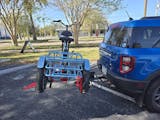
E-Bike Classes Explained: What You Need to Know About Class 1, Class 2, and Class 3
Share
Is going green part of your New Year’s resolution? Have you been wanting to switch to using an electric bike? With the increasing popularity of e-bikes and the many benefits they offer, it's no surprise that more and more people are considering making the switch. Electric bikes have unquestionably had a significant impact on the industry.
Choosing the right e-bike can be overwhelming with many options available. Factors to consider include the type of electric motor, level of assistance, and your riding needs and location. In the United States, e-bikes are classified into three main classes: Class 1, Class 2, and Class 3. But what do these classifications mean, and which one is right for you?
In this blog post, we will explore the differences between Class 1, Class 2, and Class 3 e-bikes and help you determine which class is best suited for your needs. Let’s get started learning about the differences between all three e-bike classes.
Similar to motorcycles, electric bikes are classified into different categories based on their basic functionality.
Class 1:
Class 1 e-bikes have a maximum speed of 20 mph and are equipped with an electric motor that works when the rider is pedaling, also known as a pedal assist system (PAS).
What exactly is pedal assist? It is an electric bike operating mode in which, once activated, the motor kicks in while you pedal. It is designed to make pedaling easier, Pedal assist features a variety of settings that will let you ride at your desired speed with ease.
When you start pedaling with assistance or when the motor is engaged, your e-bike can reach speeds of up to 20 mph. Once you reach this point, the motor will no longer provide assistance. Class 1 e-bikes are typically unrestricted, and you can ride them on most bike trail
In summary, e-bikes are classified as class 1 if they are equipped with pedal assist only, have a top speed of 20 mph, and do not have a throttle.
Class 2:
Class 2 electric bikes that provide assistance when pedaling and have a maximum speed of 20 mph with a throttle.
What is a throttle, and how does it work exactly? A throttle is a feature found on e-bikes that can be a grip twist or a button that you hold down to provide forward momentum without the need for pedaling. However, 20 mph remains the power limit, and the throttle will stop working if you exceed that speed.
 Figure 1. Thumb Throttle |
 Figure 2. Twist Throttle |
Although some individuals may not prefer a throttle on their e-bike, it has been demonstrated to be quite useful. For example, when riding uphill or after a long ride, a cyclist may desire to cruise to their destination. Electric bikes can be quite heavy, and depending on the terrain, the additional power provided by a throttle can be necessary to get moving.
Some examples of Class 2 e-bikes include the X-Treme Malibu, X-Treme Newport Elite, and the Emojo Caddy Pro electric tricycle.
Figure 3. X-Treme Malibu Elite Class 2 Electric Bike
Class 3 E-Bike:
What makes a class 3 e-bike a class 3 e-bike? A class 3 e-bike features Pedal Assist only and tops off at 28 mph. The class 3 electric bikes are also the fastest. Instead of getting assistance only up to 20 mph, class 3 e-bikes offer assistance up to 28mph. In that case, the motor will stop contributing and will assist you once you start pedaling. Due to the high power class 3 e-bikes have, they are restricted from certain bike trails and bike paths. Another requirement for this class is for your electric bike to have a speedometer.
In the All Around E-Bikes catalog, some of our favorite Class 3 bikes are the Bikonit Bikes and Revibikes Cheetah.

Figure 4. Bikonit Class 3 Mid-Drive Electric Bicycle
Can e-bikes go even faster? Technically, yes. However, Class 1 and 2 motors shut off at 20 mph, and Class 3 motors shut off at 28 mph. Any additional speed is gained by rider power alone and/or decreasing elevation (riding downhill).
The rules and regulations for e-bikes differ depending on where you live. The e-bike classes in the United States may change. Some enthusiasts refer to e-bike class 4. As of this writing, the definition has not been widely adopted. Local bike shop dealers are typically well-informed about the regulations and classification of e-bikes in their area. To learn more about policies and laws and regulations about e-bikes visit peopleforbikes.org.
Electric bikes are becoming important vehicles in people’s daily lives. It mixes the advantages of standard bikes and electric motorcycles, permitting less effort and gathering more pleasure while riding.
All Around E-Bikes carefully selects the brands of the most reliable e-bikes on the market. As an authorized dealer of the brands we carry, your purchase is backed by the manufacturer's warranty.
We inspire the readers to ride e-bikes in the park, climb hills, and cycle for alternative transportation. We believe in the amazing transformation that e-bikes provide and are dedicated to spreading the joyful and sustainable experience they provide.
For more information about the e-bikes covered and their features or warranties, you may contact us at 1-888-725-4887.



